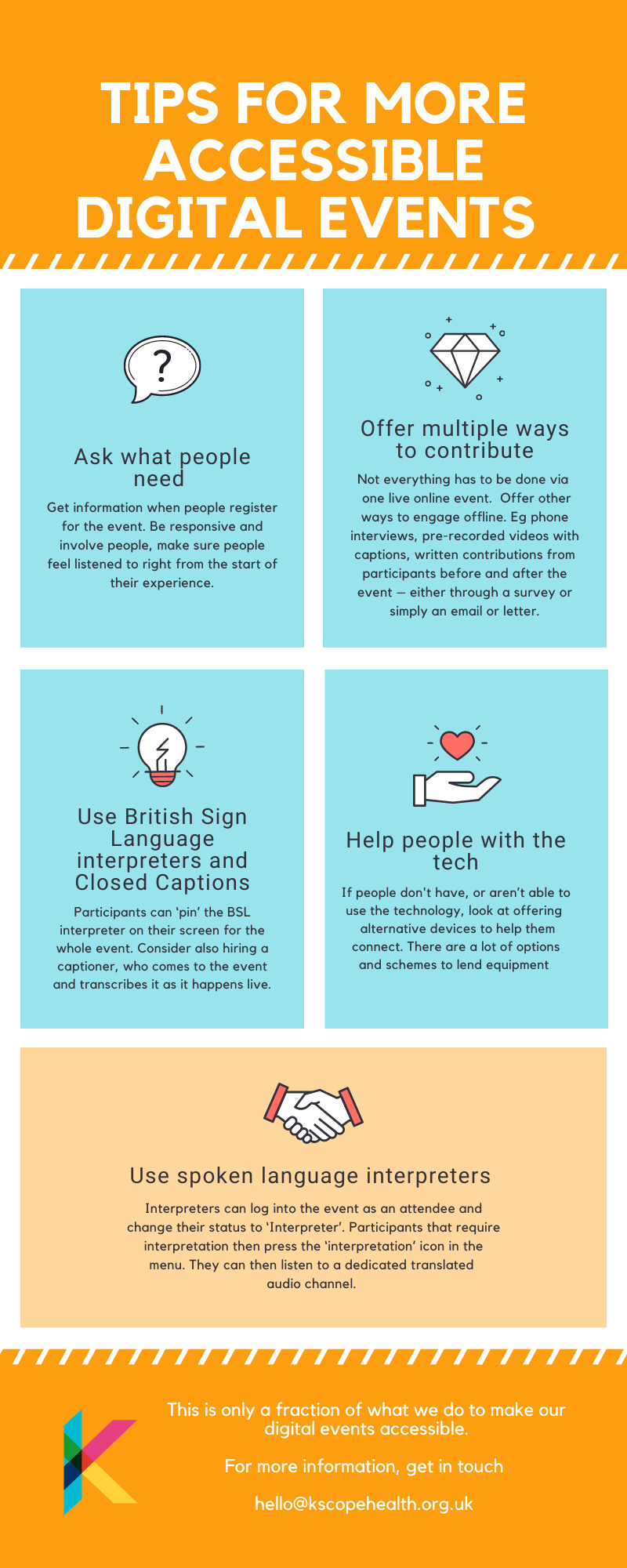How to run accessible digital events
We are doing so many meetings and events digitally now, Lydia Paris reflects on how we have made them as accessible as possible. Here she shares her 10 top tips for an engaging and inclusive digital event.
At Kaleidoscope we regularly work with people who have access requirements. So how do we make an event accessible, let alone engaging, when running it through a screen?
Most of the learning here comes from our work with Camden Council and its partners to design and deliver a citizens’ assembly on health and social care. Working closely with the assembly members, we figured out what would work best for their needs.
The membership includes deaf people and blind people. Some members have no access to the internet or digital devices and some have learning difficulties. Several members do not have English as a first language and require interpreters.
Here are our top 10 tips building on what we learnt about how to run an accessible digital event:
1. Keep it simple
When designing your event, keep it simple. Then go back and make it even more simple. Less is more. One of the top reasons why participants enjoy our events is having a chance to engage with others, simple structures allow for that. When you add in multiple accessibility needs, simplicity becomes even more important.
Keep the event short (90 mins max), have a clear set of objectives, don’t overfill the agenda, keep speakers to a minimum, and have plenty of time for any breakout sessions.
2. Double down on audio and visual cues
It is important not to rely on either visual or audio cues. Anything which is presented visually at the event should also be presented audibly, and vice versa.
3. Ask your participants what they need
A crucial point both to ensure you meet the right requirements, and also to ensure participants feel involved in the decision. When participants register for your event, ask if they have any access requirements you should know about. For those who do, speak to them directly about what they need. Also encourage them to have a ‘tech test’ with you in advance of the event, to ensure they know how to use the technology and any provisions to improve access, e.g. closed captions.
When designing your event, keep it simple. Then go back and make it even more simple. Less is more.
4. Use British Sign Language (BSL) interpreters and Closed Captions
If participants need it, we use BSL interpreters who attend the whole event. Be aware that you’ll need at least two BSL interpreters so each can work in 20-minute bursts at a time.
Ask BSL interpreters and event participants using BSL to arrive 30 minutes before the event starts. It is a good idea to run a tech test so you can ensure they are briefed, can use the technology properly and the interpreters know who their participants are. The participants ‘pin’ the BSL interpreter on their screen for the whole event, including in breakout rooms, so they see them only.
Consider also hiring a captioner, who comes to the event and transcribes it as it happens live. This can be useful for people who are deaf/hearing impaired but not familiar with BSL, as well as people for whom English is not their first language.
Bonus tip: As event facilitator/organiser, make sure you don’t ‘spotlight’ anyone else during the event, as this will override the pinning of BSL interpreters.
5. Hook participants up with the internet and/or a digital device if you can
If your participants aren’t able to use the technology required, look at offering them alternative devices to help them connect. We were able to borrow equipment for people through the Camden library and tech charities.
Though for most of us it is a nicer experience to see what is happening at the event, if operating the technology is going to prove more stressful than it is helpful, suggest that they dial in by telephone instead.
6. Use spoken language interpreters
If some of the participants are not English speakers, consider having interpreters join the event. There is also the closed captions route, but not all languages are catered for with that.
For this, interpreters log into the session as an attendee and change their status to ‘Interpreter’. Participants that require interpretation are then instructed (by the interpreters) to press the ‘interpretation’ icon in the menu. The attendee now only hears the translated audio channel. The interpreter follows the attendee into the breakout rooms.
Again, ask both parties to join the session 30 minutes before the start and to set everything up in good time.
7. Offer multiple ways to contribute
A live digital event isn’t the only way to contribute to a conversation. Consider supplementing your online event with other ways to engage offline. For example, try offering phone interviews, sharing pre-recorded videos with captions, and/or encouraging written contributions from participants before and after the event – either through a survey or simply an email or letter.
8. Set up a dedicated helpline
We have found that having a dedicated person managing a ‘helpline’ phone is the best way to support people who are really struggling with the technology during the event. We shared the helpline phone number with participants ahead of the event as well as during, so they could pick up the phone at any point for any serious tech hiccups.
9. Communicate before and after the event
For many of our events, face-to-face or digital, we send an ‘information pack’ out before the event. This helps participants, particularly those with access requirements, prepare before the event starts. As well as materials about the event content, we include all necessary technical information, including a ’Zoom user guide’, to maximise accessibility.
We also send information out after each event – typically a write-up and reminders of any actions participants should take. If we know there are participants without digital access, we send any information both by email and by post (in their first language and using braille where needed).
10. Have a facilitator in each breakout group
If there are a number of different participants with specific access requirements, it can be all the more important to keep your breakout groups small (5-6 people) and have a facilitator in each one. This ensures the discussion is easy to follow for, say, participants with deafness. The facilitator, as a ‘co-host’, can also control who is muted or not if needed, rather than participants having to worry about it. And, remember, ensure that interpreters are put into the same group as their respective participants!
That is quite a lot to think about but if there is one most important take-away from all of it, it is to ask participants what they want and need. Be led by them, always.
Let us know in the comments section if you have any more tips – we’d love to hear!

 Lydia Paris31 July 2020
Lydia Paris31 July 2020

Comments